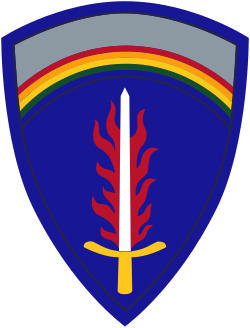United States Department of the Army

Das United States Department of the Army (deutsch etwa „Heeresamt der Vereinigten Staaten“) ist eine von drei Fachabteilungen innerhalb des Verteidigungsministeriums der Vereinigten Staaten (United States Department of Defense). Sein Vorläufer war bis zum National Security Act von 1947 das Kriegsministerium.
Anders als das US-Marineamt bzw. einst -ministerium (Department of the Navy) besaß das Department of the Army von seiner Gründung im Jahr 1947 an nie Kabinettsrang. Beide nehmen gemeinsam mit dem gleichfalls 1947 geschaffenen Luftwaffenamt (Department of the Air Force) die administrativen und technischen Aufgaben für die jeweiligen Teilstreitkräfte unter dem Dach des Department of Defense wahr.
Das Department of the Army wird vom Secretary of the Army (Heeresstaatssekretär) geführt; dies ist seit dem 28. Mai 2021 als 25. Amtsinhaberin Christine Wormuth. Der SECARM ist ziviler Angestellter, der für die administrative Seite der US Army zuständig ist, oberster Kommandeur der militärischen Kommandokette ist jedoch der Chief of Staff of the Army.
Aufbau
(Kommandobehörden und unterstellte Großverbände)
| Army Commands | Current commander | Location of headquarters |
|---|---|---|
| GEN Michael X. Garrett | Fort Bragg, North Carolina | |
| GEN James M. Richardson (acting) (Juli 2022) | Austin, Texas | |
| GEN Edward M. Daly | Redstone Arsenal, Alabama | |
| GEN Paul E. Funk II | Fort Eustis, Virginia | |
| Army Service Component Command | Kommandeur | Garnison |
| GEN Christopher T. Donahue | Lucius D. Clay Kaserne, Wiesbaden, Deutschland | |
| LTG Patrick Frank | Shaw Air Force Base, South Carolina | |
| LTG John R. Evans Jr. | Joint Base San Antonio, Texas | |
| GEN Charles A. Flynn | Fort Shafter, Hawaii | |
| MG Daniel R. Walrath[2] | Joint Base San Antonio, Texas | |
| LTG Stephen G. Fogarty[3] | Fort Belvoir, Virginia[4] | |
| LTG Daniel L. Karbler | Redstone Arsenal, Alabama | |
| LTG Jonathan P. Braga | Fort Bragg, North Carolina | |
| Operational Force Headquarters | Kommandeur | Garnison |
| LTG Willard M. Burleson III | Camp Humphreys, Südkorea | |
| Direct reporting units | Kommandeur | Garnison |
| Katharine Kelley[7] (civilian) | Arlington, Virginia | |
| Mr. Ronald (Rob) Richardson (civilian) | Fort Belvoir, Virginia | |
| Carol Burton[9] (civilian) | Fort Belvoir, Virginia | |
| LTG Scott A. Spellmon[10] | Washington, D.C. | |
| Director Gregory D. Ford | Quantico, Virginia | |
| MG Thomas R. Drew | Fort Knox, Kentucky | |
| MG Michele H. Bredenkamp | Fort Belvoir, Virginia | |
| LTG R. Scott Dingle | Joint Base San Antonio, Texas | |
| MG Allan Pepin | Fort Lesley J. McNair, Washington, D.C. | |
| BG James J. Gallivan[11] | Aberdeen Proving Ground Maryland | |
| MG David C. Hill | Carlisle, Pennsylvania | |
| LTG Steven W. Gilland | West Point, New York |
Weblinks
- Über das Hauptquartier des Department of the Army (englisch)
- Zivile technische Berufsangebote im Department of the Army (englisch)
Einzelnachweise
- ↑ (13 November 2020) Army General Order NO. 2020–31: REDESIGNATION OF UNITED STATES ARMY EUROPE AS UNITED STATES ARMY EUROPE AND AFRICA AND REDESIGNATION OF UNITED STATES ARMY AFRICA/SOUTHERN EUROPEAN TASK FORCE AS UNITED STATES ARMY SOUTHERN EUROPEAN TASK FORCE, AFRICA
- ↑ ARSOUTH CG Biography
- ↑ (1 Jun 2018) New commander assumes leadership of U.S. Army Cyber Command
- ↑ list of the most recent Army General Orders (AGO). In: Army Electronic Publication System. Archiviert vom am 18. Juli 2016.
- ↑ General Orders No. 2012-02: Redesignation and Assignment of Eighth Army as a Subordinate Command of The United States Army Pacific. Department of the Army, archiviert vom am 4. März 2016.
- ↑ Archived copy. Archiviert vom am 3. Februar 2015; abgerufen am 7. Februar 2015.
- ↑ Who is Kate Kelley? allgov.com, abgerufen am 13. Dezember 2018.
- ↑ DAGO 2017-03, DESIGNATION OF THE UNITED STATES ARMY CIVILIAN HUMAN RESOURCES AGENCY AND ITS SUBORDINATE ELEMENTS AS DIRECT REPORTING UNIT, apd.army.mil, dated 4 January 2017, last accessed 13 January 2017
- ↑ Welcome to CHRA - About Us. chra.army.mil, abgerufen am 22. Januar 2021.
- ↑ Lieutenant General Scott A. Spellmon, 55th Chief of Engineers and Commanding General of the U.S. Army Corps of Engineers
- ↑ Lindsey Monger (July 21, 2020) Change of command ceremony marks change in ATEC leadership
- MG Joel K. Tyler command of ATEC June 7, 2018atec.army.mil ( vom 15. August 2018 im Internet Archive)
Auf dieser Seite verwendete Medien
U.S. Department of The Army Emblem.
- In the center is a Roman cuirass below a vertical unsheathed sword, point up, the pommel resting on the neck opening of the cuirass and a Phrygian cap supported on the sword point, all between on the right an esponton and on the left a musket with fixed bayonet crossed in saltire behind the cuirass and passing under the sword guard.
- To the right of the cuirass and esponton is a flag of unidentified designs with cords and tassels, on a flagstaff with spearhead, above a cannon barrel, the muzzle end slanting upward behind the cuirass, in front of the drum, with two drumsticks and the fly end of the flag draped over the drumhead; below, but partly in front of the cannon barrel, is a pile of three cannon balls.
- To the left of the cuirass and musket is a national color of the Revolutionary War period, with cords and tassels, on a flagstaff with spearhead, similarly arranged above a mortar on a carriage, the mortar facing inward and in front of the lower portion of the color and obscuring the lower part of it; below the mortar are two bomb shells placed side by side.
- Centered above the Phrygian cap is a rattlesnake holding in its mouth a scroll inscribed "This We'll Defend."
- Centered below the cuirass are the Roman numerals "MDCCLXXVIII."
- For differences between this text description and the emblem shown above, see "Army Seal vs. Army Emblem", below.
Seal of United States Department of the Air Force - military department for the United States Air Force and the United States Space Force
United States Army South Shoulder Sleeve Insignia
W3C-validity not checked.
U.S. Military's Arlington National Cemetery Seal
U. S. Military Academy Shoulder Sleeve Insignia
U.S. Army Medical Command Patch
United States Army Military District of Washington Insignia
U.S. Army Training And Doctrine Command Shoulder Sleeve Insignia
Blazon
- Description: A disc 2 1/2 inches (6.35cm) in diameter overall consisting of three vertical stripes of equal width of blue, yellow and scarlet, the blue to the left, all within a 1/8 inch (.32cm) Army green border.
Symbolism
- The shoulder sleeve insignia was formerly that of the Replacement and School Command, World War II, which was charged with the responsibility of training Army personnel.
- The three stripes are in the colors of, and refer to, the basic combat arms; they also refer to the components of the "One Army" concept: Active Army, Army Reserve and Army National Guard.
Background
- The shoulder sleeve insignia was originally approved for the Replacement and School Command on 1943-03-22.
- It was reassigned to the U.S. Army Training and Doctrine Command on 1973-07-01.
- (TIOH Dwg. No. A-1-558)
United States Army Space and Missile Defense Command Logo
Shoulder Sleeve Insignia of the United States Army Special Operations Command.
Description: On a red stylized spearhead with a 1/8 inch red border, 3 1/2 inches in height and 2 inches in width overall, a black Fairbairn-Sykes dagger. A black tab with "AIRBORNE" in red letters is attached above the insignia.
Symbolism: The stylized spearhead alludes to the shoulder sleeve insignia worn by the lst Special Service Forces and signifies the heritage and traditions that the US Army Special Operations Command will perpetuate. The unsheathed black dagger symbolizes total military preparedness and has long been associated with Army special operation forces. The airborne tab designates the command's airborne status.
Background: The shoulder sleeve insignia was approved effective 1 December 1989.Full color USACIDC patch
Shoulder Insignia for ASAALT
Autor/Urheber: MrInfo2012, Lizenz: CC BY-SA 3.0
The Insignia of United States Army Intelligence and Security Command (INSCOM)
Fifth Army Shoulder Sleeve Insignia
*Description: On a circular background of fair sky and moderate sea with land in sinister base, a tri-mast square rigged ship under way before a fair breeze with after top-sail furled, commission pennant atop the foremast, National Ensign atop the main, and the commodore's flag atop the mizzen. In front of the ship a luce-type anchor inclined slightly bendwise with the crown resting on the land and, in front of the shank and in back of the dexter fluke, an American bald eagle rising to sinister regarding to dexter, one foot on the ground, the other resting on the anchor near the shank; all in proper colors. The whole within a blue annulet bearing the inscription "Department of the Navy" at the top and "United States of America" at the bottom, separated on each side by a mullet and within a rim in the form of a rope; inscription, rope, mullet, and edges of annulet all gold. *Background: The policy for use of the Navy seal and emblem is contained in SECNAV Instr 5030.4 and SECNAV Instr 5030.6. The seal design was approved by the President of the United States by Executive Order 10736 dated October 23, 1957. Request for use of the Navy emblem should be submitted in writing to Defense Printing Service, ATTN: DPSMO, 8725 John Kingman Rd Suite 3239, Fort Belvoir, VA 22060-6220. The telephone number is (703) 767-4218. 1879 version here: http://etc.usf.edu/clipart/54900/54985/54985_seal_navy.htm
Seal of the United States Department of Defense from 2001 to 2022.
Eighth Army Shoulder Sleeve Insignia
Army Futures Command Shoulder Sleeve Insignia




























